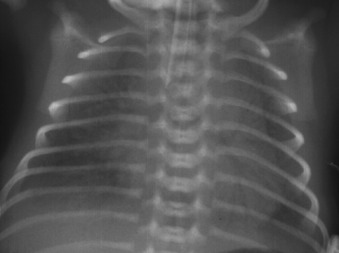Physical Address
304 North Cardinal St.
Dorchester Center, MA 02124
The lung bud is an outpouching of the primitive foregut, appearing during the fourth week of development.
The lung bud progressively branches during embryologic development, undergoing a pseudoglandular stage (weeks 5 to 17), a canalicular stage (weeks 16 to 25), a terminal sac stage (weeks 25 to 40), and an alveolar stage that begins late in fetal life and continues until approximately 8 years of age.
The appearance of the thymus is variable. The “sail” sign refers to the thymus creating a triangular shadow of soft tissue along the mediastinal border on chest x-ray.
Always check for the side of the aortic arch (normally left sided); this may be difficult to do in newborns, and the side of the aortic arch may need to be inferred by observing that the descending aorta runs to the left of the spine and that the trachea is mildly deviated to the right.
Look at heart size. In contrast to adults, the normal cardiac-thoracic ratio may be 60%. The apex of the heart should be on the left (i.e., levocardia).
Pulmonary vascularity should be assessed. This assessment may be difficult, but some clues to increased vascularity include seeing vessels behind the liver density or noting that the right descending pulmonary artery is larger in diameter than the trachea.
Look at the bones (especially the vertebrae for any segmental anomalies), and note whether the humeral heads have ossified (this happens at 40 weeks of gestation).
Look under the diaphragm for organomegaly and the position of the stomach bubble (normally in the left upper quadrant.)
Since you are generally not going to forget to look at the lung fields, try to do that last to make sure they are clear.
The umbilical arterial catheter (UAC) should terminate below the L3 vertebra or at the level of the T6 through T9 vertebrae to prevent catheter occlusion of branch vessels arising from the aorta. The umbilical venous catheter (UVC) should terminate at the inferior cavoatrial junction; passage into the right atrium or projection of the catheter over the liver requires repositioning.
The UAC can be identified by its initial inferior extension into the pelvis as it courses from the umbilicus via one of the paired umbilical arteries into an internal iliac artery before it turns to ascend within a common iliac artery and abdominal aorta to the left of the spine. The UVC courses posteriorly from the umbilicus via the umbilical vein through the left portal vein and ductus venosus into the inferior vena cava, where it then ascends to the right of the spine.
Surfactant is produced by type II pneumocytes. It is a complex substance containing phospholipids and apoproteins, which acts to reduce surface tension and prevent alveolar collapse. Lack of sufficient surfactant in prematurity leads to diffuse microatelectasis and respiratory distress syndrome (RDS).
RDS is caused by an insufficient amount of surfactant. A surfactant dysfunction may be caused by a mutation in one of the surfactant proteins. Surfactant dysfunctions, such as from mutations in surfactant proteins B, C, or ABCA3, can have a variety of radiologic manifestations in the lungs, including diffuse ground glass opacities, cysts, crazy-paving, or even (as a late manifestation) fibrosis on computed tomography (CT). Surfactant dysfunction may also occur in the setting of meconium aspiration.
The radiographic appearance of RDS is a diffuse, symmetric, or patchy ground glass appearance to the lung parenchyma with low lung volumes ( Figure 85-1 ).

Maternal corticosteroids are administered intramuscularly and have been shown to promote surfactant production if preterm delivery is imminent. Exogenous (intratracheal) surfactant administered to the neonate is also beneficial. Infants requiring intubation may develop complications such as air leaks in the form of pneumothoraces; pneumomediastinum; or pulmonary interstitial emphysema (PIE), which appears as linear interstitial lucencies. Long-term consequences of barotrauma and increased oxygen exposure include neonatal chronic lung disease, which may manifest as diffuse interstitial thickening and hyperaeration.
Transient tachypnea of the newborn (TTN).
Congestive heart failure (CHF).
Neonatal pneumonia.
Meconium aspiration.
Become a Clinical Tree membership for Full access and enjoy Unlimited articles
If you are a member. Log in here